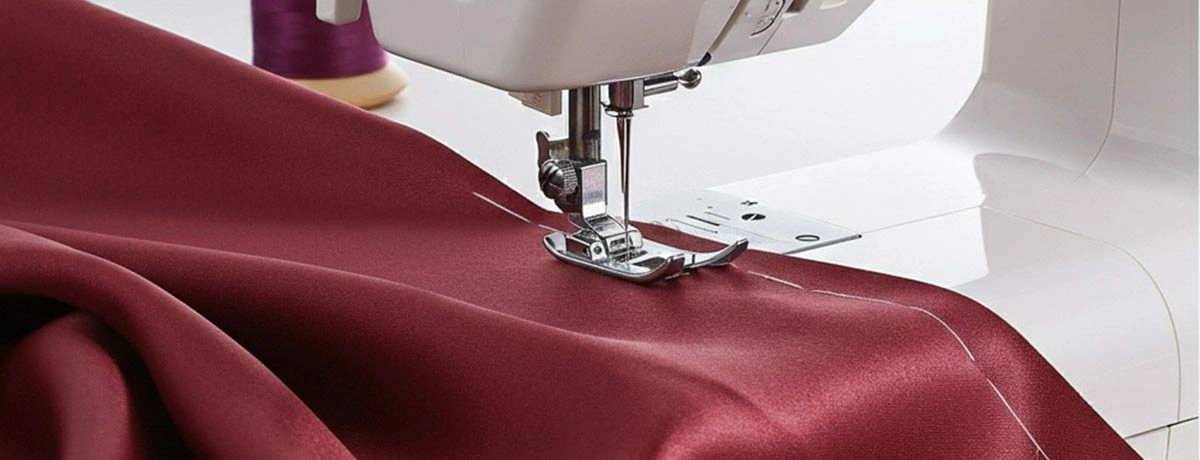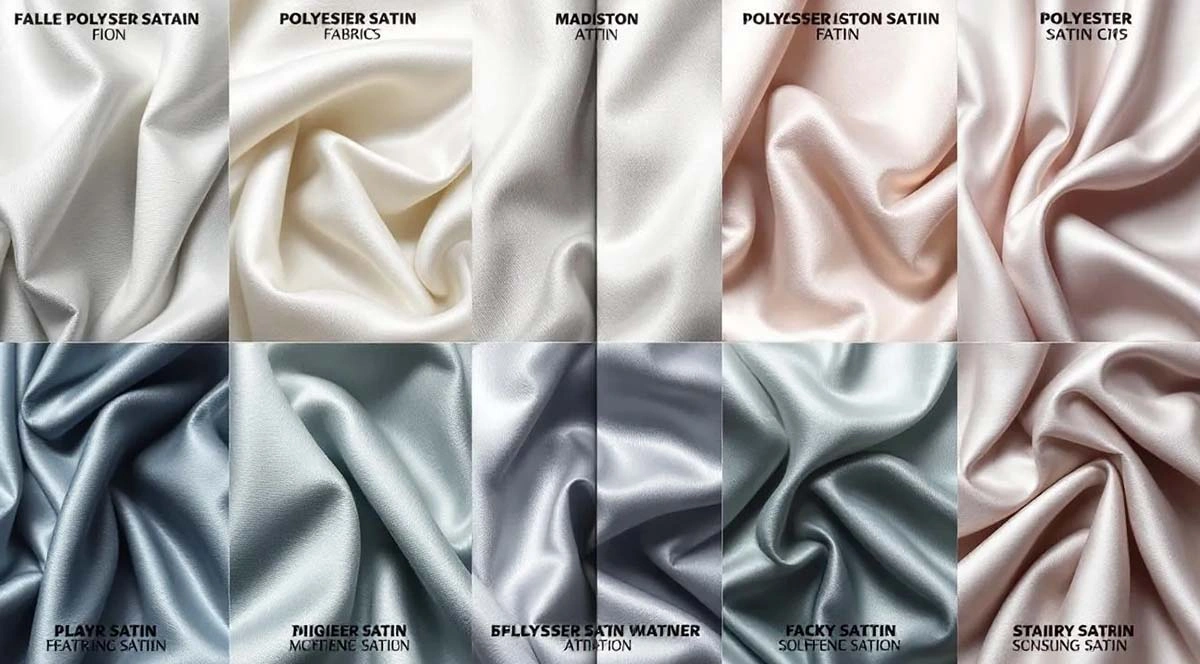How to Sew Polyester Satin: 8 Best Tips for a Flawless Finish

Sewing polyester satin requires special care because of its slippery texture and tendency to pucker. In this guide, you’ll learn how to sew polyester satin by selecting suitable tools, preparing the fabric, adjusting your sewing machine, and employing special techniques to create professional-looking garments with polyester satin.
Key Takeaways
-
Polyester satin is beautiful but requires careful handling to avoid water stains and snagging; always align pattern pieces along the fabric grain.
-
Choose high-quality polyester satin for better drape and opacity, and pre-wash your fabric to prevent shrinkage and remove chemicals before sewing.
-
Use a Microtex needle and lightweight polyester thread for smooth stitches, and modify machine settings to avoid puckering while sewing.
Understanding Polyester Satin
Polyester satin is a durable, affordable, and visually stunning fabric that has become a staple in many sewing projects. Its luxurious smoothness and distinctive sheen make it a popular choice for garments that need to stand out. However, sewing satin fabric requires a delicate touch due to its slippery nature and propensity to pucker, especially when working with a satin weave.
One of the common issues you might encounter with polyester satin is the development of water stains and potential snagging on rough surfaces. Exposure to water, steam, or even water-based markers can lead to irreversible changes in the fabric’s appearance, so special care is needed when handling and sewing satin.
It is crucial to understand the fabric grain of the fabric. This knowledge helps maintain the optimal appearance and drape of satin garments. Properly aligning pattern pieces correctly along the grain helps prevent distortion during sewing, ensuring your finished piece looks as beautiful as the fabric itself.
Choosing the Right Polyester Satin

Satin fabrics come in various types, including:
-
Polyester satin
-
Acetate satin Each offers unique qualities that can significantly impact your sewing project. Knowing these differences helps in selecting the right satin fabric, as satin refers to the type of weave that gives it its characteristic sheen, for your specific needs. Additionally, satins can enhance the overall aesthetic of your creations.
When choosing polyester satin, consider the weight and drape of the fabric. High-quality polyester satin drapes well and provides excellent opacity, enhancing the final look of your garment. Ensure the fabric’s characteristics match your project’s requirements to achieve the desired outcome.
Quality satin fabric significantly impacts the overall appearance and feel of the finished piece, making the investment worthwhile. Look for gorgeous fabric with good drape, opacity, and minimal fraying to ensure your sewing project shines. Using quality fabric shears can also enhance your cutting experience with beautiful fabric. Satin material can elevate your designs even further.
Pre-washing and Pressing Polyester Satin
Pre wash polyester satin prevents shrinkage and removes any sizing or residual chemicals that might affect its performance during sewing. This step ensures that your finished garment maintains its shape and quality after the first wash.
When it comes to pressing polyester satin, use a dry iron on a low heat setting with a pressing cloth to avoid damaging the fabric. Avoid using steam, as it can create water spots and alter the fabric’s lustre. Pressing satin properly maintains its smooth and shiny appearance.
Maintain the integrity of polyester satin by using gentle cleaning methods. Harsh chemicals can weaken the fabric fibers, so always opt for mild detergents and handle the fabric with care.
Cutting and Pinning Techniques
Cutting polyester satin requires precision and the right tools to avoid slippage and maintain accuracy. Always cut one layer at a time using sharp scissors or a rotary cutter for the best results. This approach ensures precise cutting and minimizes fabric distortion.
Using a non-slip cutting mat and securing your slippery fabric with pattern weights can prevent the satin from moving as you cut. This technique helps maintain the fabric’s alignment and consistency, which is crucial for achieving a flawless finish.
When pinning satin, consider the following tips:
-
Use extra fine dressmaking pins to minimize snagging and visible marks.
-
Avoid regular pins as their blunt tips can damage the delicate fabric.
-
Align all pattern pieces in the same direction to maintain a consistent sheen in your satin project. Additionally, using sharp pins and fine pins can help achieve precise placement.
Selecting Needles and Threads
Selecting the appropriate sewing machine needle for your sewing machine is vital when working with polyester satin. Consider the following:
-
Use a Microtex needle, which is highly recommended.
-
It minimizes the chances of snagging.
-
It creates neat, precise stitches.
-
This needle type is specifically designed for delicate fabrics like satin.
Opt for lightweight polyester thread to ensure smooth seams and prevent bulky seams in finished seams. This type of thread complements the delicate nature of satin and helps achieve a flawless finish in your sewing projects.
Regularly change the universal needle to avoid snagging the fabric and leaving needle marks on the satin. A fresh barbed needle with a sharp point ensures clean and precise stitching, preserving the beauty of the satin fabric.
Adjusting Sewing Machine Settings
Modify your sewing machine settings to sew satin without issues. Lowering the tension helps avoid puckering seams, which is a common problem when sewing satin fabric.
For lightweight satin, use a needle size ranging from 9 to 10 and consider using a walking foot to manage the slippery nature of the fabric. This helps maintain an even feed and prevents the fabric from shifting during sewing. Here are some tips for sewing.
Start by conducting a tension test on a scrap piece of satin before starting your main project. Use scrap pieces of satin for this test seams to check for pull marks. This ensures your machine settings are optimized for the fabric, leading to a professional finish.
Special Sewing Techniques for Polyester Satin

Use a wider seam allowance and seam allowances when sewing polyester satin to secure seams and prevent fraying. This technique provides extra stability and ensures that your seams stay intact.
Finishing the edges of satin fabric neatly is crucial for a polished look. Using a serger or overlock machine helps achieve clean and professional finished edges, preventing satin frays and giving your garment a sewn appearance with an overlock stitch.
Fine threads like polyester or silk thread reduce the risk of puckering and contribute to a smooth finish in your satin project. These threads are gentle on delicate fabrics and enhance the overall quality of your sewing.
Proper Storage and Handling
Store polyester satin properly to prevent damage like crease formation. Rolling the fabric rolled on a cardboard tube helps maintain its smooth appearance and prevents unwanted folds.
When handling polyester satin, keep the following in mind:
-
Always use clean hands.
-
Avoid applying hand cream, as oils can stain the fabric.
-
Use consistent handling and proper storage techniques to help maintain the quality and beauty of your satin fabric.
Summary
Sewing polyester satin can be a rewarding experience when you follow the right techniques and precautions. From understanding the fabric’s unique qualities to choosing the right tools and adjusting your sewing machine settings, each step is crucial for achieving a flawless finish.
With patience and practice, you can master sewing with satin and create stunning garments that showcase the fabric’s beautiful sheen and luxurious drape. So, gather your satin fabric, follow these tips, and embark on your next sewing project with confidence.
Frequently Asked Questions
Why is polyester satin a popular choice for sewing projects?
Polyester satin is a favorite among sewists because it combines durability and affordability with a beautiful sheen, perfect for adding a touch of elegance to any project. You really can’t go wrong when choosing it for your creations!
What types of needles and threads should I use for polyester satin?
You’ll want to go with a Microtex needle and lightweight polyester thread for sewing polyester satin. This combination will give you smooth, precise stitching without risking any damage to your fabric.
How do I prevent water spots when pressing polyester satin?
To prevent water spots when pressing polyester satin, use a dry iron set to a low heat and always include a pressing cloth. This will help keep the fabric looking its best while avoiding any water damage.
What are the best techniques for cutting and pinning polyester satin?
For cutting and pinning polyester satin, make sure to use sharp fabric shears or a rotary cutter alongside a non-slip cutting mat and pattern weights for accuracy. When pinning, opt for extra fine dressmaking pins to prevent snagging the delicate fabric.
How should I store polyester satin to maintain its quality?
To keep your polyester satin in top shape, roll it on a cardboard tube to prevent creases and always handle it with clean hands to avoid any oil stains.
Contact MH
MH offer felt fabric. Please contact us for more details or inquiries. We're here to help!


